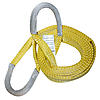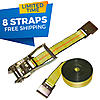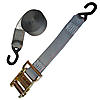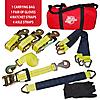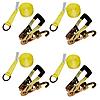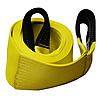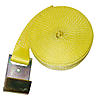We often hear from our customers wondering what are the main differences between traditional tie-down straps and tow straps. Today we will be going over some of the main questions we receive and how to determine which is the best strap to use during your next securement or tow. Let’s begin.

The Differences Between Tie Down Straps and Tow Straps
The main difference between tie-down straps and tow straps is the type of webbing blend that is used to make each of the straps. Two different types of webbing are used for securement and towing applications securement-based applications using polyester webbing and towing using tow strap webbing.
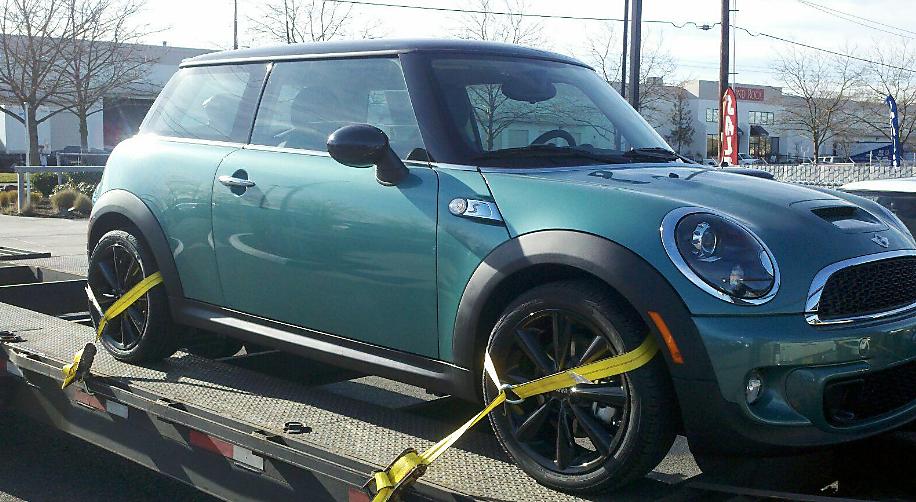
Polyester Tie Down Webbing – Polyester is used in straps such as Ratchet Straps, E Track Straps, Endless Loop Straps, Hunting Straps, Car Tie Down Straps, Cam Buckle Straps, Tent Straps, Winch Straps, and other custom tie-down straps that are used to hold items in place or to keep secured in place for transit. Polyester webbing is most commonly thought of webbing blend as it is used in pickup trucks, professional semi-trucks, moving vans, around the house DIY applications, and pickup trailers to name a few of the many different applications. Polyester tie-down webbing straps should never be used as recovery tow straps as they could cause potential damage to your vehicle which could result in costly repairs.

Tow Strap Webbing – Tow strap webbing stretches a lot more compared to polyester webbing and is used for recovering vehicles that have become stuck in the sand, snow, mud, ice, tall weeds, water, and more. The reason this is the webbing blend of choice for automotive vehicle recovery applications is when the vehicle is being pulled out of a tough spot the stretching helps to take the tension off of the vehicle itself. Taking tension off of the vehicle components themselves can help to prevent sudden jerks that could cause bumpers to come off, wheels to bend, or other structural components of your vehicle to fail. You should never use tow strap webbing for tie-down securement applications as the added stretching to prevent damage when towing could cause the vehicle, cargo, or other belongings to come undone.

Things to Look for in a Tie Down Strap
Some of the most important things to look for in a tie-down strap include the working load limit that you are needing to secure the cargo that you are transporting safely. Every tie-down strap in the United States is required to have a working load limit tag sewn onto the strap for it to be deemed safe to use by the Department of Transportation industry standards. If the strap you are looking to purchase does not have a working load limit (WLL) tag it is unsafe to use and the strap should not be purchased or used to secure cargo.
Another thing to look out for is the type of webbing blend. As previously discussed in this blog the webbing is incredibly different between tie-down straps and tow straps and you should always look for a webbing blend that stretches very little when you are looking to secure cargo. The webbing that stretches is at risk of causing the cargo to come out of place or out of securement which could cause the cargo securement to fail. The phrase “cheaper, the better” does not always apply to the cargo securement industry, and the safety of yourself, others on the roadway, and the cargo you are securing should be taken into consideration before securement. A strap that you found online for the cheapest price may be the strap with the largest amount of risk of failing. It’s crucial that you buy from reputable and trusted tie-down strap manufacturers when it comes to your load securement.
Things to Look for in a Tow Strap
Some of the most important things to look for in a tow strap is the webbing being stretchable. Having a stretchable tow strap could result in the strap causing serious damage to your vehicle or even potential injury to yourself or others. Tow Straps should also be purchased from reputable companies and also follow the catchphrase “cheaper isn’t always better”. Remember to follow the correct breaking strengths of webbing for your towing application and to use tow hooks when possible.
The Risk of using Ratchet Straps for Towing Applications
As we’ve discussed in this article damage from using the incorrect strap can cause expensive damage to vehicles. We tend to find that not many people purchase ratchet straps for towing applications. Rather, someone passing by someone stuck in a bind in snow, ice, sand, mud, or other elements that requires a vehicle to help the stuck vehicle only has a ratchet strap to use. Although the intentions are likely good from the other person passing by the potential damage can cause a quick headache.
We always strongly urge customers especially during the winter months to plan ahead and keep a tow strap in their vehicle’s emergency kit at all times to help prevent this situation from causing an otherwise costly damage repair bill to your vehicle. This should include other parts of your emergency kit such as a first aid kit, blankets, an ice scraper for those who are around snow, phone chargers, jumper cables, and some spare food and water to help prepare for the worst-case scenarios. You can read some of our other winter driving tips in our How to Prepare for Snow Storms HERE.
There are two main types of recovery tow straps that are used for recovery applications and depending on the weight of the vehicle the perfect strap may be different for everyone who purchases these straps. 1-Ply tow straps as the name implies are made with 1 ply of our tow strap webbing blend and are designed for lighter-weight recovery applications such as four-wheelers, ATVs, golf carts, snowmobiles, lighter weight cars. Our 2-ply recovery tow straps use 2 plies of our tow strap webbing and are much more durable and heavy-duty and can be used for most normal recovery tow applications such as golf carts, ATVs, UTVs, motorcycles, golf carts, lawnmowers, tractors, farm equipment, cars, trucks, and more!

Frequently Asked Tie Down Strap and Tow Strap Questions
How long do tow straps last? – It ultimately depends on the amount of usage that the straps are being used. If you keep it stored in the back of a vehicle for long periods and maybe use it a handful of times per year you could easily expect the strap to last longer than 5 years. If you are someone who goes on the off-road type of adventures often the strain on the strap that is reduced from the vehicle to protect it may cause the strap to last not as long.
How do Cordura Eyes work on tow straps? – Cordura sleeves and Cordura eyes help with durability on the straps as they provide a layer of protection between the strap and the item you are pulling. This especially helps if the area you are pulling is in an area with sharp edges, rusty areas of the vehicle, or in elements where extreme amounts of force are used.
How Long Can Tow Straps be in Length? – 30 feet is our standard longest tow strap that can be found in our Recovery Tow Straps section of our website.
How long do tie-down straps last? – Similar to how long do tow straps last it ultimately depends on the usage. If you are someone who secures often or someone who secures cargo with sharp corners and you are not using corner protectors you are likely going to go through straps faster than someone who is using them every couple of weeks for around the house projects. You can greatly increase the lifespan of the straps by going with heavy-duty webbing over the standard tie-down webbing as well as the webbing is usually the first thing to fail on tie-down straps. You can also increase this further by using Cordura sleeves and corner protectors during your next securement application.
Do you need more than one Tow Strap? – No, you should be able to remove most vehicles, farm equipment, or other various objects without the need to use more than one tow strap. If the weight exceeds or if the vehicle is unable to help assist or more the object there may be a need for numerous vehicles and numerous tow straps. This is extremely rare and often does not happen though unless the object has become stuck in deep mud, water, or sand.
